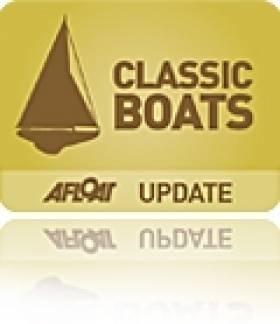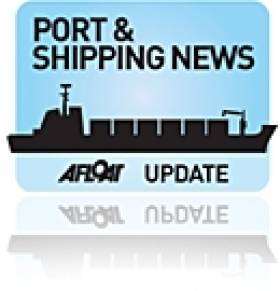Displaying items by tag: HMS Caroline
Launch of Appeal to Begin to Find Relatives of Naval Battle Veterans
#HMScaroline – A large scale appeal to find descendants of sailors from the island of Ireland who served in the First World War Battle of Jutland is to be launched in the New Year.
The Newsletter also writes that, a series of events will be held on May 31 marking the centenary of a famous naval battle, in which thousands of men lost their lives.
The last surviving vessel of the Battle of Jutland, HMS Caroline as Afloat reported on will also be launched as a heritage visitor attraction in Belfast.
History Hub Ulster is supporting the Northern Irish Executive and Republic of Ireland Government in encouraging relatives of Irishmen who served at sea in the First World War to share their stories.
Thousands of men and women from across the island assisted the war effort at sea and in maritime roles. For more on the story, click here.
Belfast-Based Battleship from WWI to be Restored Into Museum
#HMScaroline – The National Museum of the Royal Navy (NMRN) has been boosted by a £1m lottery funding to turn Belfast-based HMS Caroline into a visitor attraction in time for the 1916 Battle of Jutland centenary celebrations off the coast of Denmark.
The derelict vessel, which is currently docked in the same Belfast shipyards where the Titanic was built, was in danger of rusting away or even being scrapped before moves to restore it started to build up steam two years ago.
The Heritage Lottery Fund has now awarded £11.5 million to fund the work ahead of 2016. For further coverage of this development, The Belfast Telegraph has a report HERE.
#TitanicPumpHouse – The Belfast Telegraph writes that the historic pump-house that was used for the dock in which the RMS Titanic was built, is to be transformed into a visitor centre for HMS Caroline.
The listed building is the subject of a new planning application by the National Museum of the Royal Navy, which is working towards reopening HMS Caroline to public view in 1916.
HMS Caroline is one of the most historic fighting ships in the world and is the last remaining survivor of the Battle of Jutland, the largest ever maritime battle during the First World War.
She is to be restored to her former glory and it is hoped she will reopen in time for the centenary of the battle at the end of May 1916. To read more details of the plan, click HERE.
As previously reported on Afloat.ie, repairs were carried out late last year on HMS Caroline that involved vital weatherproofing as part of the major restoration programme.
Repairs Start on Belfast's Warship Caroline
#WWICruiser –Repairs to vital weatherproofing have started on HMS Caroline in advance of major restorative work to turn the famous World War One fighting ship as previously reported into a floating museum in Belfast.
It came dangerously close to sinking during the big freeze of 2010 when pipes and radiators burst, but work is well under way to protect it from the ravages of another potential harsh winter.
Deck timbers are being replaced to prevent the risk of more flooding and a major internal inspection of space below the water line is being carried out. For more The Belfast Telegraph reports.
HMS Caroline Has Potential to be Key WWI Commemoration Project
HMScaroline – As previouslt reported, the Belfast-based former WWI warship HMS Caroline could create "one of the most significant World War One commemoration projects in the world".
The claim has been made by the grandson of the admiral who commanded the Royal Navy's Grand Fleet in 1916. HMS Caroline has been docked at Alexandra Dock in Belfast since 1923.
Plans to transform it into a floating museum are progressing. The fast light cruiser played a lead role in the 1916 Battle of Jutland in which the Royal Navy forced the German Imperial Navy to retreat to port.
For much more on this development, BCC News Northern Ireland has a report.
Lottery Funding Confirmed for HMS Caroline
#HMSCaroline – The last remaining warship of the Royal Navy's Grand Fleet, HMS Caroline which fought at the Battle of Jutland in 1916, has been confirmed with a grant from the Heritage Lottery Fund.
The project to transform the historic Belfast-based vessel into a floating museum has been boosted by a £845,600 grant, which is to see the veteran warship undergo transformation.
The money will enable the National Museum of the Royal Navy to draw up more detailed plans to bid for a full grant of £12.2m.
For further details about the veteran vessel which is berthed at the Alexandra Dock visit the National Historic Ships UK website.
Birthday Bash as HMS Belfast Celebrates 75th Anniversary
#HMSBelfast – The Thames floating landmark, HMS Belfast celebrates its 75th anniversary, coinciding with this weekend's St. Patrick festivities held on both sides of the Irish Sea, writes Jehan Ashmore.
The Town-Class cruiser was launched on St. Patrick's Day 1938 from Harland & Wolff, Belfast. She is one of the last surviving WW2 warships remaining in UK waters. She was commissioned into the Royal Navy the following year and placed under the command of Captain G.A. Scott DSO.
During her career, HMS Belfast opened fire in support of Allied troops during the D-Day landing, was on escort duty during Artic convoys of merchant ships in addition to involvement in the Korean War.
To commemorate the historical significance of HMS Belfast, which has been moored on the Thames since 1971 as a major tourist attraction, a series of special events are to be held this weekend.
Her Belfast-based counterpart, the C-Class light cruiser HMS Caroline, which served in World War I having been built in 1914 at Cammell Laird, Birkenhead, lies on the Lagan.
As previously reported, the fate of the former Battle of Jutland survivor was secured following last year's decision to protect the vessel from falling into disrepair with a £1m restoration grant.
On completion of the work on the veteran vessel now in her 99th year, she is to become a major tourist attraction likewise of HMS Belfast.
£1m to Restore Belfast’s Historic Warship
#HMS CAROLINE – The last surviving floating warship of World War I,HMS Caroline has been secured with a £1 million restoration grant.
The National Heritage Memorial Fund (NHMF) is funding the project to protect Belfast-based HMS Caroline from falling into disrepair.
This grant awarded to the National Museum of the Royal Navy (NMRN) will enable urgent repair works to the light cruiser including making the ship wind and water tight and incorporate the removal of dangerous asbestos.
To read more The Belfast Telegraph has a report.
Ports & Shipping Review: Ferry Disruption, Remembering Seafarers, Naval Service First, Shipping Awards and Newbuild Abis Dublin
#PORTS & SHIPPING REVIEW - Over the last fortnight Jehan Ashmore has reported from the shipping scene where Celtic Link Ferries sailings between Rosslare and Cherbourg resumed operating, following mooring issues encountered in Cherbourg.
Memorial services were held in Dublin and Cork for the National Commemoration Services for Irish Seafarers. In addition to church services held, wreaths were laid in the capital at the memorial to Irish Seafarers at City Quay.
The Naval Service Base on Haulbowline, was the setting for an historic occasion as three women were promoted to the rank of Petty Officer.
Retaining to a naval theme, in Belfast, where WWI cruiser HMS Caroline is berthed, veterans and relatives of those who served on board are being invited to contribute memories to a project carried out by National Museum of the Royal Navy (NRMN).
In the latest analysis released from the Irish Maritime Development Office (IMDO) the volume of port and shipping traffic remained relatively stable in the third quarter of 2012, in which a breakdown of the five main shipping sectors is outlined.
Carl-Johan Hagman has been appointed new CEO of Stena Line, the 46-year old replaces Gunnar Blomdahl, who has served in this role for more than a decade of the Swedish owned ferry giant which celebrates its 50th anniversary this year.
The IMDO sponsored the Short Sea Shipping Company of the Year 2012 which went to Stena Line in Rosslare, at the annual Irish Exporters Association's Export Industry Awards. In the category for Deep Sea Shipping Company, sponsored by the Port of Cork Company the award went to Hapag-Lloyd while in the Seafood Exporter Award, the honour went to Errigal Seafoods.
Sailings on the winter season service between Douglas-Liverpool (Birkenhead) were resumed by the Isle of Man Steam Packet Co.'s ro-pax Ben-My-Chree.
Abis Dover, a new Dutch built multipurpose heavy-cargoship unloaded wind-turbine components in Dublin Port. The D-class 6,000 tonne newbuild is to be joined by a sister Abis Dublin which is due for delivery this December.
Ports & Shipping Review: Cruising to the Sun, WWI Warship’s Tourist Role, Stena’s 50th Year, Cargoship Record, Dock Survey of Lighthouse tender and more…
#PORTS & SHIPPING REVIEW - Over the last fortnight Jehan Ashmore has reported from the shipping scene where Irish passengers left wintery conditions by embarking on a cruise directly from Dublin Port which was bound for sunnier climes in Iberia and the Atlantic isles.
A multi-cat workboat, Island Kestral was acquired by Wicklow based Island Shipping, the vessel will be chartered to offshore projects including the renewables industry sector.
Following the fate of the WW1 Battle of Jutland cruiser HMS Caroline, which is to remain in Belfast, the 98-year vessel is to be made into a tourist visitor attraction, likewise of London's HMS Belfast, another veteran but from WW2.
Those considering a career at sea, should take note that the National Maritime College of Ireland (NMCI) is to host a 'Open' Day next Tuesday (23 October) at the campus based in Ringaskiddy.
What's in a name...Stena Line, a household name, but did you realise that the Swedish owned ferry giant derives its name from founder Sten A. Ollsen, and this year celebrates its 50th anniversary. How did the company become to where it is today, operating 19 routes which includes Dun Laoghaire-Holyhead, served by the HSS Stena Explorer, which is to return to the route for 12 days during the festive and new year periods.
While Irish Sea rivals, Irish Ferries is to add a third ferry on to the Dublin Port-Holyhead route also to cover for the festive and new year sailings. The unprecedented transfer of the Isle of Inishmore will join the route's existing tonnage, Ulysses and fast-ferry Jonathan Swift, to provide additional capacity during the busy season.
Those with a strong interest in liners, should head for the London Ship Show next Saturday (27 October). Among the exhibitors are maritime booksellers, artists, model-makers, traders in memorabilia and ephemera postcards. There will be talks about P&O Cruises 175th anniversary 'Grand Event' in the Solent which featured the Arcadia that sailed to Dublin.
A major international conference on Ocean Energy was held in Dublin's Convention Centre and facing opposite the venue, a scientific weather buoy was positioned on the Liffey.
Passengers travelling on ferry routes will be able to have the same travel rights given to those flying or taking the train, when the National Roads Authority is to implement on 18 December.
A record breaking single cargo shipment of 56,000 tonnes of coal, was set in Belfast Harbour, when the bulk-carrier Ocean Breeze docked in the port having sailed from Virginia in the U.S.
Irish Rail which operates Rosslare Europort is to undergo a strategic review, which is predominantly served by the ferry sector, could be transferred to potentially different ownership.
Today the tallship Tenacious is having an 'Open' Day, where the public can board the 65m barque berthed at Sir John Rogersons Quay in Dublins Docklands between 10.00am-12.30pm and 2-4pm.
The hard-working lighthouse tender ILV Granuaile is undergoing a docking survey in Cork Dockyard. The vessel was built in Galati on the River Danube, Romania for the Commissioners of Irish Lights whose headquarters are in Dun Laoghaire, which is the vessel's homeport.





































































